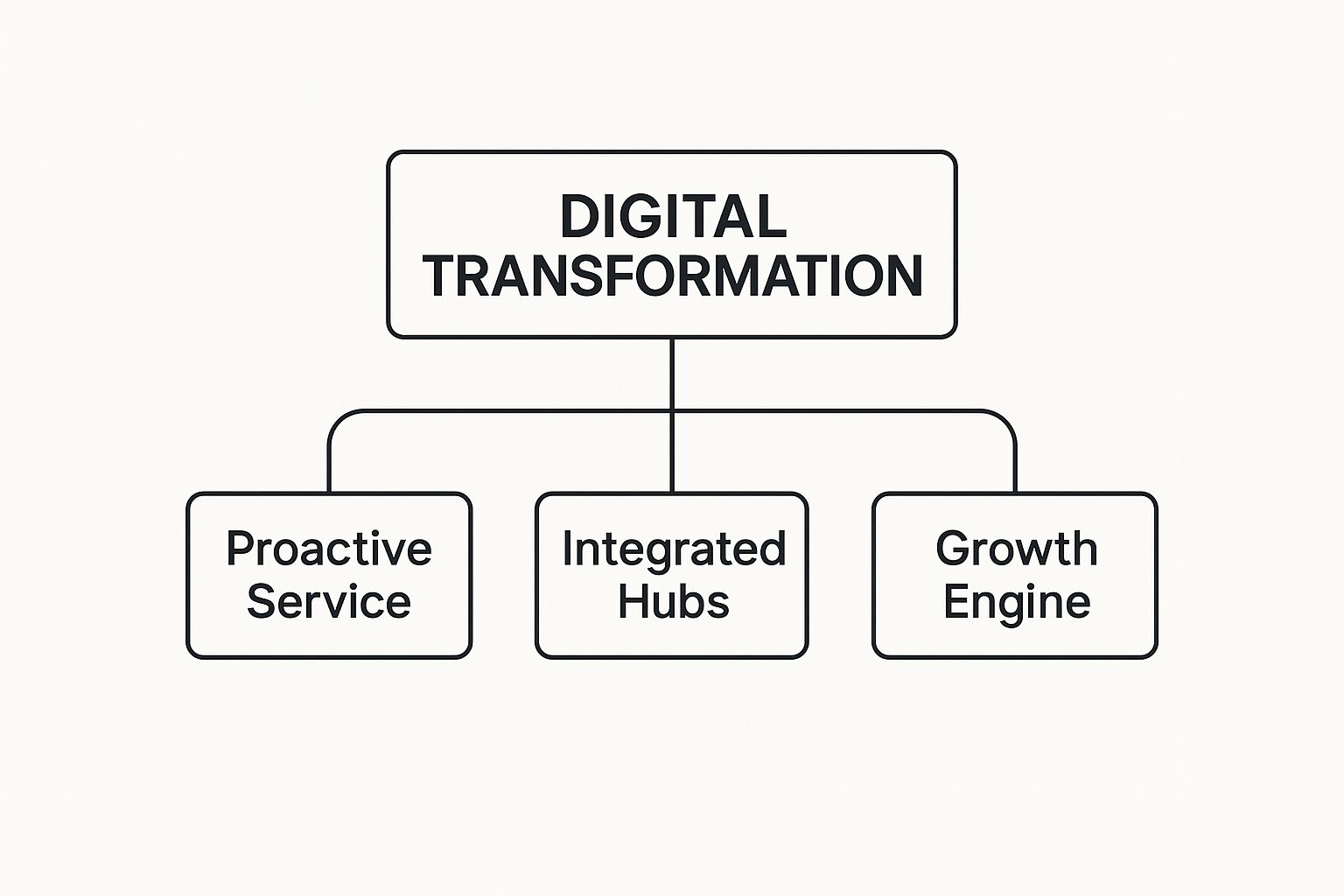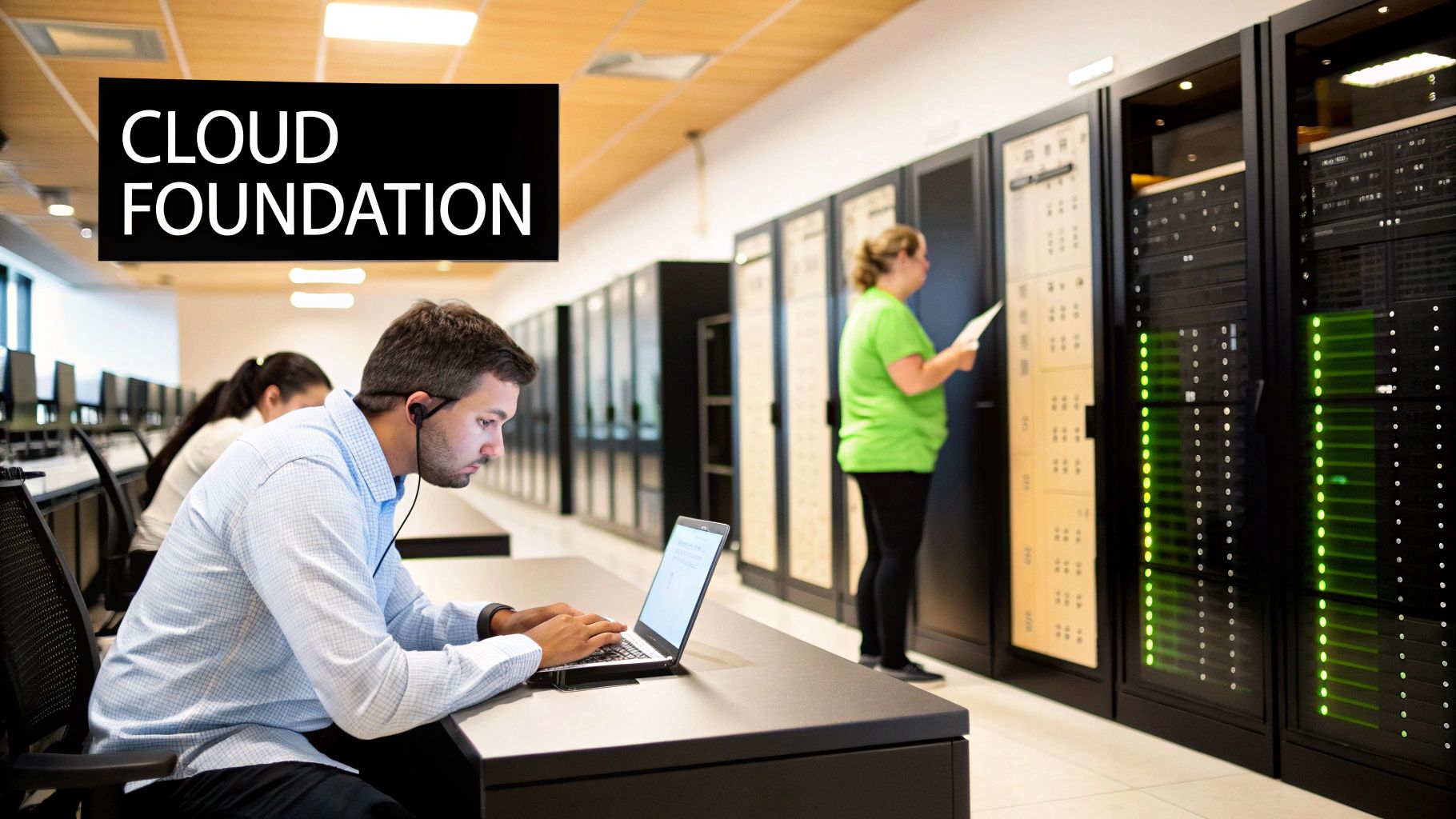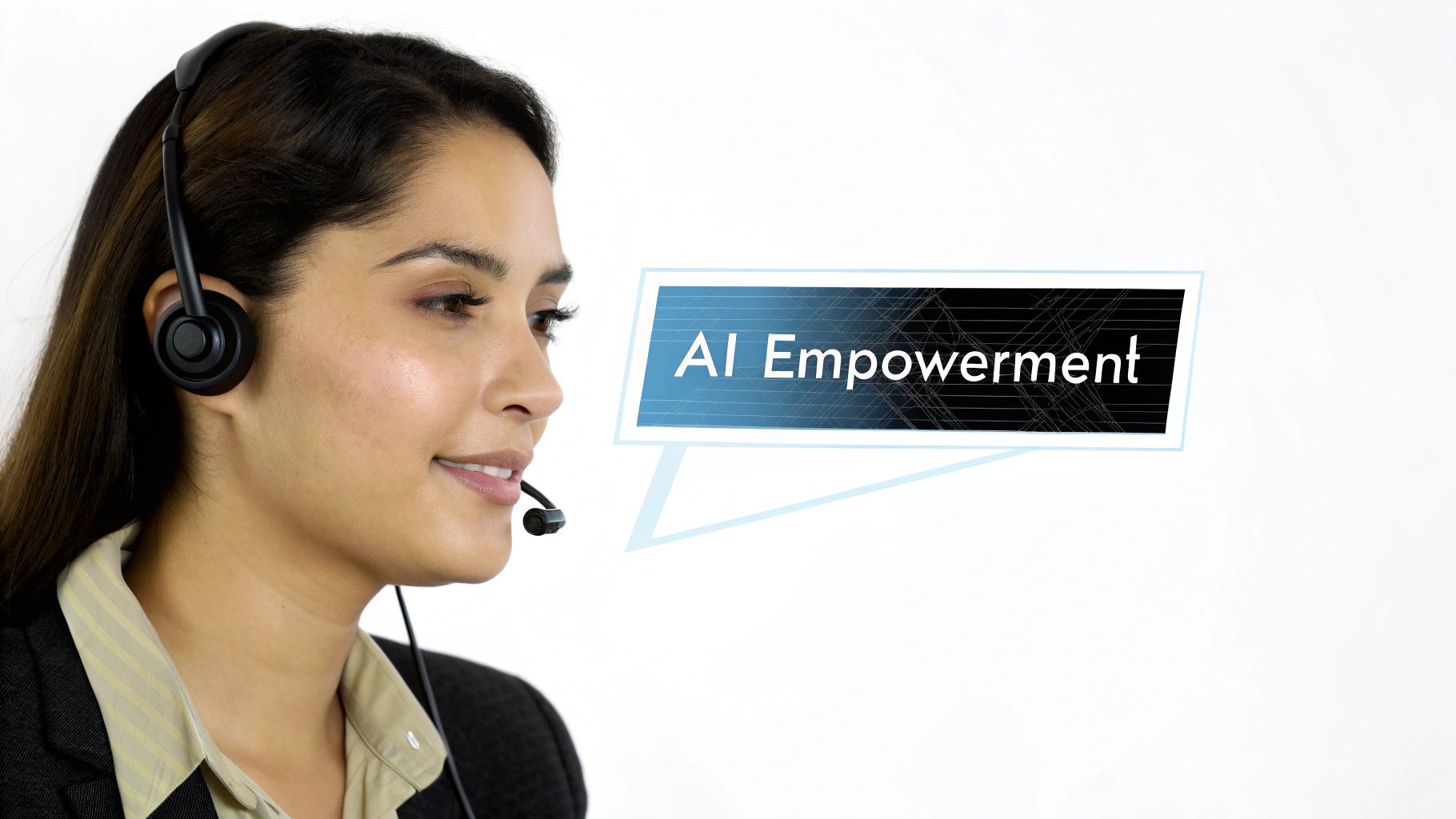Contact center digital transformation is all about flipping the script—moving away from the old-school, reactive call center model to a smart, proactive customer experience hub. It's about bringing in tools like AI, cloud platforms, and omnichannel communication to create the kind of smooth, personal interactions that build real loyalty and drive growth.
Think about the jump from a clunky rotary phone to the smartphone in your pocket. That’s the kind of leap we’re talking about here. Shifting to a digital contact center is so much more than just plugging in some new software. It’s a complete overhaul of how a business talks to its customers, driven by sky-high consumer expectations and some seriously powerful new tech.
Today’s customers want help now, on whatever channel they prefer, whether that’s a web chat, a social media DM, or a good old-fashioned phone call. The last thing they want is to repeat their problem to three different people or get stuck in a hold queue. This demand for a frictionless experience is pushing companies to ditch the siloed, reactive call center that just sits and waits for the phone to ring.
Traditionally, the contact center was seen as a necessary evil—a cost center designed to put out fires and not much else. But a contact center digital transformation turns that whole idea on its head. By integrating intelligent tools and linking up all communication channels, the modern contact center becomes a hub for proactive engagement.
This new approach is built on three core pillars that change the entire mindset from just fixing problems to actively driving business growth.

This evolution takes a department that was once just reacting to issues and transforms it into an integrated system focused on proactive service and expanding the business.
Instead of just waiting for something to go wrong, this new model anticipates what customers might need, offers easy self-service options, and gives agents the tools they need to build genuine relationships. Suddenly, every single interaction is a chance to gather insights, make the service better, and strengthen customer loyalty.
A digitally transformed contact center doesn't just solve problems; it creates value. It turns every customer touchpoint into a chance to strengthen brand affinity, identify upselling opportunities, and gather crucial feedback for the entire organization.
This strategic pivot brings a ton of advantages that directly boost the bottom line:
A successful contact center overhaul isn't about one big, dramatic change. It's more like building a house. You need a solid foundation, sturdy walls, a smart electrical system, and a central brain to run everything. Get one part wrong, and the whole structure is wobbly.
The same is true for your customer experience hub. It’s built on four interconnected pillars that, together, create an operation that’s stronger, smarter, and ready for whatever comes next. Each pillar fixes a specific weakness of old-school call centers, and understanding how they fit together is the first step toward a real strategy.
The first and most important pillar is Cloud Infrastructure. For decades, contact centers were shackled to physical servers humming away in a back room. This setup was a nightmare to maintain, a fortune to scale, and made supporting a remote workforce nearly impossible.
Moving to the cloud, usually with a Contact Center as a Service (CCaaS) platform, is like swapping a fixed office building for a flexible, on-demand workspace. It’s the bedrock that all other advancements are built on, giving you the agility to grow or shrink without sinking a ton of cash into hardware.
Next up is Omnichannel Communication. This is where we stop just offering different channels—phone, email, chat—and start weaving them into one seamless conversation. In a multi-channel world, a customer's chat and their later phone call are two separate events.
An omnichannel approach makes sure the context follows the customer. If they start with a chatbot, move to live chat, and then need to hop on a call, the full history of that interaction moves with them. This single change eliminates the #1 customer frustration: having to repeat themselves over and over. In fact, nearly 90% of customers get annoyed when they have to explain their issue to multiple reps.
Omnichannel isn't just about being everywhere your customers are. It's about creating one continuous, intelligent conversation that makes them feel heard, no matter how they choose to connect.
The third pillar, AI and Automation, is the intelligent engine that makes everyone’s job easier. Let's be clear: this isn't about replacing your agents. It's about giving them superpowers. AI-powered tools are perfect for handling the repetitive, boring tasks, which frees up your team to solve the complex, high-stakes problems where a human touch is essential.
Think of it this way: AI chatbots can field common questions 24/7, while robotic process automation (RPA) handles the mind-numbing after-call work like data entry. For agents, AI becomes a co-pilot, whispering real-time suggestions during calls or instantly pulling up the right knowledge base article. This turns every agent, even a brand new one, into a seasoned expert.
Finally, we have Data Analytics. If the other pillars are the structure, systems, and engine, analytics is the brain that makes sense of it all. Every single interaction across every channel generates a mountain of data. Without the right tools, it’s just noise.
Modern analytics platforms turn that raw data into clear, actionable insights. You can spot trends in customer complaints before they blow up, measure agent performance with incredible detail, and even start predicting what customers will need next. This intelligence transforms the contact center from a simple cost center into a goldmine of business strategy, informing everything from agent training to new product development.

If you want to build an intelligent, modern contact center, you have to start with the right foundation. For any meaningful contact center digital transformation, that foundation is the cloud. Period.
Trying to stack advanced tools like AI or omnichannel solutions on top of old, on-premise hardware is like building a skyscraper on sand. It’s unstable, painfully slow, and it’s just a matter of time before it all comes crashing down.
For decades, contact centers were chained to physical server rooms. This model was incredibly rigid. Scaling up for the holiday rush meant buying, installing, and maintaining racks of expensive new hardware. Scaling back down was even harder, leaving you paying for capacity you didn't need. It made adapting to market changes a slow, costly nightmare.
The cloud, usually delivered through a Contact Center as a Service (CCaaS) model, completely flips that script. It swaps out those massive upfront capital investments for a flexible, pay-as-you-go subscription. This one change gives you the agility to not just survive but actually thrive when things get unpredictable.
The operational freedom of the cloud became crystal clear in recent years. Before 2020, most contact centers were stuck in traditional, brick-and-mortar offices. When the world shifted to remote work, it forced a massive, sudden migration. The organizations that already had distributed, cloud-based infrastructure side-stepped the crippling agent shortages that hit the old-school centers. A TTEC report on 2025 contact center trends dives deeper into this shift.
A cloud-based system is the engine that runs a modern, distributed workforce. It unlocks some huge advantages for building a more resilient operation:
The move to the cloud isn't just an IT upgrade; it's a strategic business decision. It transforms your operational model from one of rigid constraints to one of limitless flexibility, scalability, and resilience.
Beyond the workforce benefits, a cloud foundation is what makes future innovation possible. Think of it as a universal adapter for all the other pieces of your digital transformation—omnichannel communication, AI, and advanced analytics. With on-premise systems, adding a new tool was often a massive, months-long IT project.
In a cloud environment, integrating new features is often as simple as flipping a switch or connecting to an API. This "plug-and-play" approach means you can test and adopt new technologies as they come out, making sure your contact center never gets left behind.
Whether you're adding a new social media channel or rolling out an AI-powered agent assistant, the cloud provides the agile backbone you need to constantly evolve. For any business that's serious about its long-term success, that kind of agility is non-negotiable.

So you have a phone number, an email address, and a live chat window. That means you're omnichannel, right? Not quite. This is one of the biggest misconceptions in contact center digital transformation. In reality, that setup is just multi-channel—offering multiple doors for customers to knock on, but with no hallway connecting them on the inside.
Think of a multi-channel experience as a series of disconnected phone calls. Each time a customer switches from chat to email, they're starting a brand-new conversation. They have to reintroduce themselves, re-explain their problem, and repeat all the details they just gave someone else. It's frustrating for them and inefficient for you.
A true omnichannel experience, on the other hand, is like one continuous conversation that flows effortlessly from one medium to another. It doesn’t matter if the customer starts on a chatbot, moves to email, and then calls in a week later. The context follows them, creating a single, unbroken thread.
The magic behind a true omnichannel setup is a unified platform that demolishes the walls between your communication silos. Instead of separate systems for voice, chat, email, and social media, everything plugs into one central hub.
This unified view gives your agents a complete history of the entire customer journey, regardless of the channel. When a customer moves from a chatbot to a live agent, that agent doesn't just see a name; they see the entire chat transcript, the pages the customer viewed on your site, and any previous tickets.
This immediate access to context is a total game-changer. Agents can skip the repetitive questions and get straight to solving the problem, which slashes handle times and stops customer frustration in its tracks.
The goal of an omnichannel strategy isn't just to be available everywhere. It's to create a cohesive, intelligent experience where the business remembers the customer's story, no matter how or where they choose to tell it.
The differences between these two approaches are stark, and understanding them is the first step toward building a truly customer-centric contact center.
Here’s a quick breakdown of what sets these two strategies apart.
While a multi-channel setup is a decent starting point, the real value lies in weaving those channels into a single, seamless experience.
Strategically weaving your channels together requires more than just the right tech; it demands a shift in mindset. You have to stop seeing customer interactions as isolated touchpoints and start viewing them as one holistic journey.
Here’s how different channels can play together in a real omnichannel ecosystem:
This level of integration is fast becoming an expectation, not a luxury. In fact, by 2025, a true omnichannel customer experience will require complete continuity of context across all channels. As some great analysis on evolving contact center trends points out, the move to cloud platforms that support this is becoming universal.
Ultimately, creating this seamless experience is how you build lasting customer trust and loyalty. When you make it easy for customers to get help and show them you value their time, you turn a simple support interaction into a powerful brand-building moment.

When you hear "AI" and "contact center" in the same sentence, it's easy to picture robots taking over headsets. But that sci-fi vision completely misses the point. The real value of AI in a modern contact center isn’t about replacement; it’s all about augmentation.
Think of AI as two new, highly specialized team members. One is a tireless front-line assistant who never sleeps, and the other is a brilliant co-pilot sitting beside every one of your human agents. Both are there to make the entire operation smarter and faster.
Let’s start with the low-hanging fruit. AI-powered chatbots and voice assistants are perfect for handling the endless stream of simple, high-volume questions. They can instantly answer things like "Where's my order?" or "What are your hours?" any time of day, without ever getting tired.
This automated first line of defense is a game-changer for two reasons:
This simple shift allows your agents to graduate from being script-readers to becoming genuine brand experts.
While automation handles the basics, AI's most powerful role is supporting your team during live conversations. It acts like an intelligent co-pilot, whispering in your agent's ear with the right information at the exact right moment.
Imagine an agent on a tricky call with a frustrated customer. Instead of fumbling through multiple systems, an AI assistant can:
AI augmentation is how you turn every agent into your best agent. It levels the playing field, giving everyone the knowledge and confidence to resolve issues faster and deliver a consistently great experience.
This support system dramatically cuts down resolution times and reduces the mental load on your agents. Even a brand-new hire can perform with the confidence of a seasoned veteran, which does wonders for reducing burnout and improving retention.
These tools aren't just a novelty; they're quickly becoming the standard. The rate of automation in agent-customer communications is expected to jump from just 1.8% in 2022 to nearly 10% by 2026. That sharp increase shows just how good AI has gotten at understanding what customers need and helping them find it on their own.
It's all about creating a smarter ecosystem where technology and people work together seamlessly. For those looking to push the envelope, you can even delve into Retrieval Augmented Generation (RAG) to build AI assistants that are even more knowledgeable and context-aware.
By empowering both your customers and your agents with intelligent tools, you’re building a support operation that isn’t just efficient—it’s exceptional.
Embarking on a contact center digital transformation can feel a lot like planning a cross-country road trip. You know the destination—a smarter, more efficient operation—but without a clear map, you’re just inviting wrong turns and dead ends. A structured roadmap breaks this journey into manageable phases, ensuring every step you take moves you closer to your business goals.
It all starts with a brutally honest assessment. Before you can figure out where you're going, you need to know exactly where you are right now. This means taking a hard look at your current operations to find the biggest sources of friction.
Pinpointing these pain points is the first, most crucial step toward building a strategy that actually works.
Once you have a handle on your challenges, it’s time to set some real, measurable business objectives. Vague goals like "improve customer experience" are basically useless. Your targets need to be concrete and tied to outcomes you can actually track.
For instance, your goals might look more like this:
These sharp, data-driven goals will act as your North Star, guiding your technology choices and making it much easier to prove the project's ROI down the line.
With your objectives locked in, you can start vetting technology partners. It's tempting to go for the flashiest new tool, but the key is finding solutions that not only fix your immediate problems but can also grow with you. A huge part of this process involves figuring out how new tech will play with your old systems. Getting familiar with effective legacy system modernization strategies can be a lifesaver, ensuring your new tools integrate smoothly instead of creating more chaos.
Trying to do a massive, all-at-once overhaul is a recipe for disaster. A much smarter approach is a phased rollout that prioritizes quick wins and builds momentum.
Start with high-impact, low-disruption initiatives. For example, deploying an AI tool to automate after-call work can deliver immediate cost savings and get your team excited for the bigger changes to come.
This iterative approach lets you pilot new tools with smaller groups, gather real-world feedback, and iron out the kinks before a company-wide implementation. It’s all about minimizing risk and making the transition as smooth as possible for everyone.
Finally, we get to the most important piece of the puzzle: change management. You could have the most advanced technology in the world, but it’s completely worthless if your team won’t use it.
Clear and consistent communication is everything. You need to explain why these changes are happening and, more importantly, how the new tools will make your agents' jobs easier, not harder.
Invest heavily in training and support to build confidence and make sure no one feels left behind. When your team is genuinely excited about the new way of working, they become advocates for the transformation instead of obstacles. This focus on people is what ultimately turns a roadmap into real, lasting success.
Even with a perfect plan on paper, big changes always bring up questions. It's just part of the process. Shifting your contact center toward a more digital-first model is a huge undertaking, so it's no surprise that leaders have a few common concerns. Let's tackle them head-on.
This is probably the biggest point of confusion, and for good reason. The idea of migrating to the cloud is often sold as the mandatory first step, but that's not always true. For a lot of big companies, a "rip and replace" of a stable, on-premise system can turn into an 18-month (or longer) project that costs a fortune and disrupts everything.
The smarter approach is about innovation without disruption. You can get incredible results by layering smart, flexible solutions right on top of the systems you already have.
The real goal is to deliver better business outcomes today, not two years from now in a perfect cloud environment. Your customers don't know or care if your system is in the cloud—they just want their problems solved fast.
So, if a full cloud migration isn't the starting line, where should you put your energy first? The experts I talk to always point to three core pieces that deliver immediate value and set you up for success down the road.
This is the question that keeps CFOs up at night. Budget is always a hurdle. The trick is to start small and zero in on projects that create clear, measurable cost savings.
A fantastic starting point is using generative AI for automated call summaries. This one simple change can slash After-Call Work (ACW), and it’s a low-risk project with results you can easily point to on a spreadsheet.
Once you start seeing those efficiency gains, you can treat that saved time as a new resource. Instead of cutting headcount, you reinvest that time into higher-value work, like proactive customer outreach or more focused agent coaching. This approach doesn't just fund the next phase of your transformation; it builds real momentum and gets everyone on board and excited for what's next.
Ready to see how AI can start delivering immediate ROI for your business? My AI Front Desk provides an AI receptionist and outbound dialer that helps small businesses convert more leads and boost revenue without a massive overhaul. Learn how our easy-to-integrate solutions can transform your customer interactions at https://myaifrontdesk.com.
Start your free trial for My AI Front Desk today, it takes minutes to setup!








